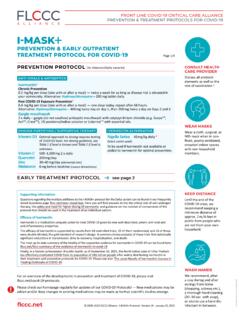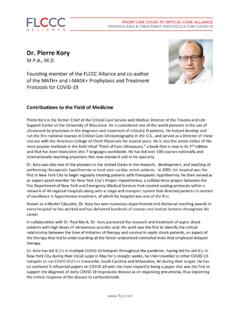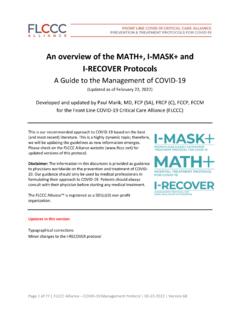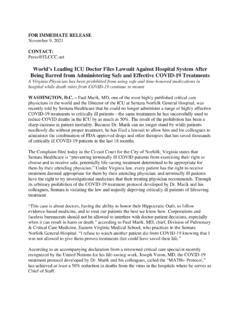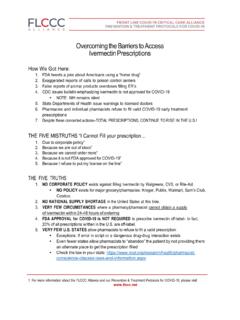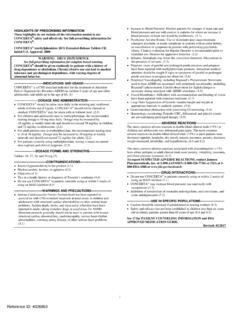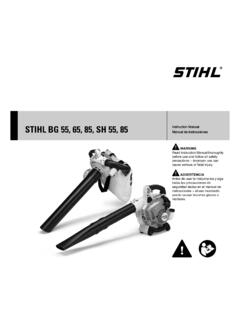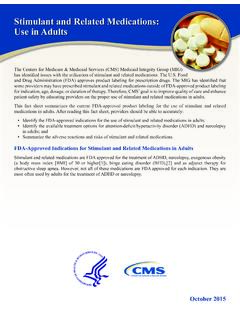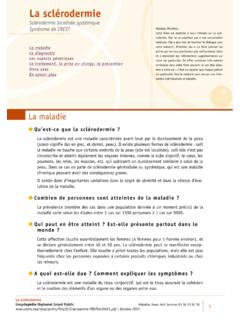Transcription of I-RECOVER | Management Protocol for Long Haul COVID-19 ...
1 FRONT LINE COVID-19 CRITICAL CARE ALLIANCEPREVENTION & TREATMENT PROTOCOLS FOR COVID-19 For updates and more information on the treatment protocols of the FLCCC Alliance please see: I-RECOVER Version 2 January 20, 2022 Page 1/4 Management Protocol for Long Haul COVID-19 Syndrome (LHCS)I-RECOVERThe approach outlined below is a consensus Protocol based on a collaboration led by Dr. Mobeen Syed ( Dr. Been ), Dr. Tina Peers, and the FLCCC Alliance. Given the lack of clinical treatment trials of Long Haul COVID-19 Syndrome, these recommendations are based on the pathophysiologic mechanisms of COVID-19 and post-viral illnesses along with our collective experience observing pro-found and sustained clinical responses achieved with the treatment approaches below. This Protocol has also been used to treat post-vaccine inflammatory syndromes with similar success. As with all FLCCC Alliance protocols, the components, doses, and durations will evolve as more clinical data accumulates.
2 If the patient presents with shortness of breath or low oxygen levels: Refer to lung specialist if available, otherwise perform chest imaging (CT preferred) to assess for second ary organizing Pneumonia (OP). If findings consistent with second ary OP found, initiate Corticosteroid Therapy as below. May need to repeat or prolong course of treat ment if symptoms or oxygen needs persist. IVERMECTIN: mg/kg body weight. Once daily for 1 PREDNISONE: 10 15 mg daily for 3 weeks. Taper to 10 mg for three days, then 5 mg for three days and then Low dose NALTREXONE (LDN): Begin with 1 mg daily and increase to mg as required. May take 2 3 months for full effect. OMEGA-3 FATTY ACIDS: Vascepa, Lovaza or DHA/EPA 4 g per day. Omega-3 fatty acids play an important role in the reso lution of inflammation by inducing resolvin production VITAMIN D: The majority of those with post- COVID-19 syndrome continue to have hypovitaminosis D. See tables 1 or 2 for vitamin D symptoms do not improve after 1 2 weeks continue steroids, omega-3 fatty acids and Naltrexone and add second line FIRST LINE THERAPIES Curcumin: 500 mg BID (has anti-inflammatory and immunomodulating properties and has been demonstrated to repolarize macrophages).
3 Nigella Sativa: 40 mg/kg/day (1 tsp grams) like curcumin it has anti-inflammatory and immunomodulating properties. Vitamin C: 500 mg BID (vitamin C inhibits histamine and repolarizes monocytes). Melatonin: 2 8 mg at night (slow release/extended release) with attention to sleep hygiene. Increase dose from 1 mg as tolerated (may cause severe nightmares at high dosages). Kefir, probiotic yogurt and/or Bifidobacterium Probiotics ( , Daily Body Restore) together with Prebiotics ( XOS Prebiotic, Bio Nutrition Pre-Biotic) to normalize the microbiome. Prolonged dysbiosis has been reported following COVID-19 infection. Behavioral modification, mindfulness therapy and psychological support may help improve survivors overall well-being and mental health. Luteolin 100 200 mg day or Quercetin 250 mg day (or mixed flavonoids). Luteolin and quercetin have broad spectrum anti-inflammatory properties. These natural flavonoids inhibit mast cells, and have been demonstrated to reduce neuroinflamma-tion.
4 H1 receptor blockers (for mast cell activation syndrome): Loratadine 10 mg daily, or Cetirizine 5 10 mg daily, or Fexofenadine 180 mg daily. H2 receptor blockers (for mast cell activation syndrome): Famotidine 20 40 mg, or Nizatidine 150 mg twice daily as tolerated. Montelukast: 10 mg/day (for mast cell activation syndrome). Caution as may cause depression is some patients. Anti-androgen therapy: Spironolactone 50 100 mg twice a day, and Dutasteride 1 mg daily. 4. OPTIONAL ADJUNCTIVE THERAPIES (in order of priority) MARAVIROC: 300 mg PO twice a day If 6 8 weeks have elapsed and significant symptoms persist this drug can be considered. Note that maraviroc can be expensive and carries the risk of significant side effects and interactions with other THIRD LINE THERAPY FLUVOXAMINE (low dose): 25 mg once daily. Stop if the symptoms increase. Caution with the use of other anti-depressants and psychiatric drugs. Taper and discontinue once symptoms improve. ATORVA STATIN: 20 40 mg once daily.
5 Caution in patients with Postural Orthostatic Tachycardia Syndrome (POTS); may exacerbate SECOND LINE THERAPIES1/41. Relative contraindications: 1) Patients on Warfarin require close monitoring and dose adjustment. 2) Pregnant or lactating women require a more in-depth risk/benefit Side effects may include: Increased appetite, mood changes, insomnia, raised blood glucose, LINE COVID-19 CRITICAL CARE ALLIANCEPREVENTION & TREATMENT PROTOCOLS FOR COVID-19 For updates and more information on the treatment protocols of the FLCCC Alliance please see: I-RECOVER Version 2 January 20, 2022 Page 2/4 Management Protocol for Long Haul COVID-19 Syndrome (LHCS)I-RECOVER2/4 Tables Achieving serum 25(OH)D concentrations above 50 ng/mL based on serum 25(OH)D concentration in non-emergency situations in a 70 kg adult *Serum vitamin D (ng/mL) **Vitamin D dose, 50,000 IU capsules: Initial and weekly **Duration (weeks)Total amount for deficit correction (IU, in millions) **Initial Dose (IU)Weekly dose (50,000 IU caps)< 10300,000x 38 15200,000x 28 20200,000x 26 30100,000x 24 40100,000 x 22 50100,000x 12 * A suitable daily or weekly maintenance dose should start after completing the schedule.
6 ** For conversion of ng/mL to nmol/L, multiply by ** Mentioned replacement doses can be taken as single cumulative doses or spread out through the week. ** Estimated deficit of vitamin D needed to replenish body stores.(Table adapted with permission from Wimalawansa)Table 1. Guidance on upfront loading dose regimens to replenish Vitamin D stores in the body Longer-term maintenance of serum 25(OH)D concentrations above 50 ng/mL based on body weight *Body-weight categoryDose (IU) kg/dayDose (IU)/dayDaily dose (IU)Once a weekBMI 19 (under-weight) 40 70 2,000 4,000~ 25,000 BMI 20 29 (non-obese person)70 100 5,000 7,000 ~ 50,000 BMI 30 39 (obese persons)100 150 9,000 15,000 ~ 75,000 BMI 40 (morbidly obese persons)150 200 16,000 30,000 ~ 100,000(Table adapted with permission from Wimalawansa)Table 2. Vitamin D dosing in the absence of a baseline Vitamin D levelFRONT LINE COVID-19 CRITICAL CARE ALLIANCEPREVENTION & TREATMENT PROTOCOLS FOR COVID-19 For updates and more information on the treatment protocols of the FLCCC Alliance please see: I-RECOVER Version 2 January 20, 2022 Page 3/4 Management Protocol for Long Haul COVID-19 Syndrome (LHCS)The Long Haul COVID-19 Syndrome (also Post- COVID-19 Syndrome ) Excerpt from the Guide to the Management of COVID-19 by Dr.
7 Paul Marik / FLCCC Alliance (version 65 from Jan 13, 2022) Please see latest version on Long Haul COVID-19 Syndrome (LHCS) is characterized by prolonged malaise, headaches, generalized fatigue, sleep difficulties, hair loss, smell dis-order, decreased appetite, painful joints, dyspnea, chest pain and cognitive dysfunction. [500 512] Up to 80% of patients experience prolonged illness after COVID-19 . LHCS is not only seen after the COVID infection, but it is being observed in some people that have received vaccines (likely due to mono-cyte/microglia activation by the spike protein from the vaccine). LHCS may persist for months after the acute infection and almost half of patients report reduced quality of life. Patients may suffer prolonged neuropsychological symptoms, including multiple domains of cognition. [509,513] A puzzling fea-ture of the LHCS syndrome is that it is not predicted by initial disease severity; post- COVID-19 frequently affects mild-to-moderate cases and younger adults that did not require respiratory support or intensive care.
8 [511] The symptom set of LHCS is in the majority of the cases very similar to the chronic inflammatory response syndrome (CIRS)/ myalgic encephalomyelitis/chronic fatigue syndrome. [511] An important differentiating factor from CIRS is the observation that LHCS continues to improve on its own albeit slowly in the majority of cases. Another important observation is that LHCS includes more young people compared to severe COVID, which affects older people or persons with comorbidities. Furthermore, the similarity between the mast cell activation syndrome and LHCS has been observed, and many consider post-COVID to be a variant of the mast cell activation syndrome. [514]The LHCS syndrome is highly heterogeneous and likely results from a variety of pathogenetic mechanisms. Furthermore, it is likely that delayed treatment (with ivermectin, etc.) in the early symptomatic phase will results in a high viral load which increase the risk and severity of LHCS. The following theories have been postulated to explain LHCS: [511]1.
9 Ongoing respiratory symptoms (SOB, cough, reduced effort tolerance) may be related to unresolved organizing pneumonia (activated pulmonary macrophages).2. Monocyte and microglia activation. Persistence of viral debris (spike pro-tein?) in monocytes and microglia results in an ongoing inflammatory response in an attempt by the immune system to clear the offending protein(s) and viral RNA The neurological symptoms may be related micro- and/or macrovascu-lar thrombotic disease which appears to be common in severe COVID-19 disease.[515] Brain MRIs 3 months post-infection demonstrated micro-structural changes in 55% of patients. [516] In addition, features of en-cephalopathy may be related to encephalitis and auto-reactive brain an-tibodies [517] as well as severe cerebral vasoconstriction. [518] The brain microvasculature expresses ACE-2 receptors and SARS-CoV-2 pseudoviri-ons may bind to the microvascular endothelium causing cerebral micro-vascular inflammation and clotting.
10 [519].4. An unmasking of mast cell activation syndrome (MCAS), or triggering of mast cell activation syndrome. Mast cells are present in the brain, especial-ly in the median eminence of the hypothalamus, where they are located perivascularly close to nerve endings positive for corticotropin releasing hormone.[520] Following stimulation, mast cells release proinflammatory mediators such as histamine, tryptase, chemokines and cytokines which may result in neurovascular inflammation.[520] The brain-fog , cognitive impairment and general fatigue reported in long-COVID may be due to mast cell related neurovascular signs and symptoms can be grouped in the following clusters. The reason for this grouping is to allow organ specific targeted therapy/individu-alized therapy. 1. Respiratory: shortness of breath, congestion, persistent cough, Neurological/psychiatric: brain fog, malaise, tiredness, headaches, mi-graines, depression, inability to focus/concentrate, altered cognition, in-somnia, vertigo, panic attacks, tinnitus, anosmia, phantom smells, etc.
